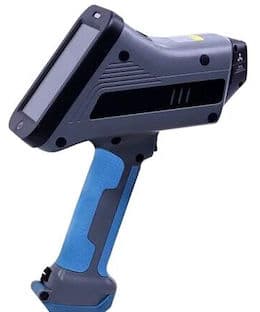
-----
Manganese electroplating (electrodeposition of manganese)
Current comments:
A. re. discussion on plating metals with manganese, which has been going on for over 150 years:
You may be interested to know that an English Professor Roscoe wrote an article in an Australian newspaper, The Empire, on 28 October 1864, on "Manganese as a replacement for gold and silver for plating purposes: more durable and less corrosive".
Sounds like they had the solution over 150 years ago.
retired - Sydney Australia
August 14, 2021
![]() Thanks Rod. That is very interesting and certainly very possible. I wouldn't go so far as to say 'very likely' though :-)
Thanks Rod. That is very interesting and certainly very possible. I wouldn't go so far as to say 'very likely' though :-)
Those were tough times for the science of electroplating due both to honest mistakes and occasional fabrications :-)
Russia greatly advanced the science of metal finishing, but odds don't seem better than about 50/50 that a reported achievement in any given book from those days was true. Similarly, in America things were announced as being plated with aluminum when in fact they were plated with zinc. That pandemic of mistakes & misinformation could have struck Australia as well. It's very hard to actually know whether a reported electroplating achievement from those days is accurate unless someone does a PhD thesis on the question to really intensively study the claim.
Luck & Regards,

Ted Mooney, P.E. RET
Striving to live Aloha
finishing.com - Pine Beach, New Jersey
Ted is available for instant help
or longer-term assistance.
August 2021
Re: Electroless and or Electroplating of Metals with Manganese.
Hi Mr Vincent,
As research Scientist who as a Postgraduate student studied on British Scholarship at the University of Birmingham in England United Kingdom. the topic of my research work was on electrodeposition of iron with Manganese from simple salt bath to produce bright coherent Fe-Mn alloy film containing intermediate atomic wt. percent composition. The project was successful resulting in a breakthrough and it was published.
In returning to the United States, I was hurried by Teledyne Continental Motors located in Mobile AL to act as a Materials Surface Engineer (SME) to resolve the inability to electrolessly co-deposit (plate) Mn with Mn and Phosphate (Fe-MnP) on its aluminum piston Aircraft Engines previously grounded by the government regulatory (the FAA). That was in about 1991 and I was successful in co-depositing Fe with MnP that was coherently bonded on the engine camshaft and piston that met the FAA flight safety requirements. I say these to demonstrate that metals are deposable or can be commercially plated with Mn to produce bright adherent alloy films possessing interesting useful properties for a critical applications.
I am in agreement with Mr. Vincent's splendid remarks.
Manufacturing Engineering Manager, Yunlin TDI LLC - Ontario, CA
December 31, 2021
⇩ Related postings, oldest first ⇩
Q. Hello,
I am an entry level engineer looking for some guidance. I am currently attempting to electroplate Mn on Mo wire. I want to use this for vapor deposition of Mn on lime glass. I am using manganese(II) sulphate, DI water, and sulfuric acid bath. Also using a Carbon Electrode and coating on 2 inch long .010/.015 diameter wire. My problem is that Mn does not want to deposit on the Mo wire. The clear solution turns a brown to black color and the carbon electrode(suppose to be inert) starts to dissolve away. Any body have some answers on why the carbon electrode is being eating away or maybe a company that might complete this task for my company.
entry level engineer - Sweetwater, Texas
2004
A. Hi Chris. For this problem please try to get access to Brenner's "Electrodeposition of Alloys". Manganese is extremely electronegative and very difficult to plate, but it is not completely impossible. Good luck.

Ted Mooney, P.E.
Striving to live Aloha
finishing.com - Pine Beach, New Jersey
Ted is available for instant help
or longer-term assistance.
2004
A. Manganese plating solution:
manganese sulphate....100 gm
ammonium sulphate
⇦ on
eBay or
Amazon [affil link]
.....75 gm
ammonium rhodanide...60 gm
up to 28 A/dm2, 25 °C temp.
According to Praktische Galvanotechnik/Saulgau 1997.
- Cerovski vrh Croatia
2004
Q. Hello,
Thanks for the help and for an example of the bath used. It has been difficult finding literature for this and I have mostly been using the example of electroplating copper with the use of a copper sulphate
⇦ on
eBay or
Amazon [affil link] bath. I found why my carbon electrode was eating away. Oxygen attacks the electrode and CO2 is given off. Does anyone have any economical ideas of an economical "inert" electrode material? I have only come up with PbO2.
Sincerely,
entry level engineer - Sweetwater, Texas
2004
A. Chris, Brenner suggests a lead-silver anode, but it really might be worth struggling to get access to that book because manganese, being difficult and tricky to plate, it is almost impossible to answer even simple questions with a short replies. For example, while Brenner says to try an anode of lead-silver, he then goes on to say "but be aware that ...." and many paragraphs about bags and diaphragms and pH differences between catholyte and anolyte, etc., then follow. Good luck.

Ted Mooney, P.E.
Striving to live Aloha
finishing.com - Pine Beach, New Jersey
Ted is available for instant help
or longer-term assistance.
2004
A. For pure Mn, it should be not so difficult. Apply a higher current or voltage is necessary.
Some literature about Mn deposition are published in Journal of the Electrochemical Society [www.electrochem.org/dl/jes/]. I am working on Mn-Co co-deposition, and have a paper published recently in Journal of Power Sources.
- Morgantown, West Virginia
2007
Ed. note: Mr. Wu's article is abstracted and and full text can be purchased at www.sciencedirect.com/science/article/pii/S0378775307025645
Q. Hello,
I am an undergraduate student in Indonesia. I'm working on my final project about manganese electroplating. It's difficult to deposit manganese on stainless steel 430 substrate. I'm using 0.6 M manganese sulphate and 1 M ammonium sulphate solution with with current density up to 20 A/dm2 . The deposit product is like powder -- fragile, not adhesive with substrate, and easily removed. Is there any better way to do manganese electrodeposition? Why is it like that?
Thank you,
Best regards,
Fadly
- Indonesia
July 4, 2012
A. First, you say nothing about cleaning or activation steps. Both are required since SS oxidizes fairly rapidly.
Next, You really need to have a Wood's Nickel strike. I like the formulation with higher HCl and lower Nickel chloride than most.
Get a copy of Safranek's book Properties of Electrodeposited Metals and Alloys
[affil link to
Amazon
or
on AbeBooks affil links] .
Lowenheim's "Modern Electroplating"
[on
AbeBooks,
eBay, or
Amazon affil links]
has a tiny bit, but may help.
- Navarre, Florida
July 6, 2012
October 10, 2012
A. Hi, I can't take a hold of nitrates nor do I know any methods of forming any sizable metal compounds, but from what I have seen so far your methods involve metal ions that coat on top of a less reactive metal.
So why is it that you guys use nitrate solutions instead of an ionic solution?
What I do is perform electrolysis to collect an oxide (copper is my favorite), then add hydrochloric acid to form an ionic solution.
Copper (blue - green liquid depending on solution's concentration).
Also you should know that for an absolute coating you will require a current (I use would use the same metal as in solution, so if using copper both anode and cathode should be copper, and make sure that the metal being coated onto is less reactive then the metal used to coat,
e.g., copper plating aluminum is not possible because aluminum is more reactive than copper, whereas copper plating iron is possible because iron is about as reactive as copper.
But most importantly, write an exact chemical equation and a hypothesis of what might happen.
So, key point:
- current through ionic/nitrate solutions
- reactivity
- chemical equation and hypothesis
This response has been given by a secondary chemistry student, who has knowledge and experience in the process of electrolysis and electroplating. Thank you and I hope that this was useful.
cya and have a good time.
- australia
![]() Thanks, Guillaume. I'm a bit confused because I didn't see anyone mention nitrate solutions, then you asked why they suggested nitrates :-)
Thanks, Guillaume. I'm a bit confused because I didn't see anyone mention nitrate solutions, then you asked why they suggested nitrates :-)
Although I didn't completely understand your descriptions, you may be right that ionic liquids could be a better approach for plating manganese than traditional aqueous plating baths.
Regards,

Ted Mooney, P.E.
Striving to live Aloha
finishing.com - Pine Beach, New Jersey
Ted is available for instant help
or longer-term assistance.
October 10, 2012
A. Hello Gentlemen. I have tried several approaches to electrodepositing Mn and Mn-Co and have concluded that the dark powdery deposit can be overcome by using a temperature of 125 °F - 137 °F and a current density of 16 - 25 ASF. I was running an ion ratio of 90% Mn / 10% Co in solution and the deposit x-rayed at 62% Mn and 38% Co, but I am making strides to overcome that by jimmying the temperature. I also used a cobalt strike plate prior to the Mn-Co interlayer and did not observe any powdery rub-off whatsoever. Anyway...FYI...just thought I would chime in.

Randall Fowler - Fowler Industrial Plating, LLC
Cleveland, Tennessee, USA
April 21, 2015
Q. I want to make a diaphragm cell for depositing Mn from MnSO4. What are the design considerations? Is there any ideal dimension for the electrolytic cell and also for anode/cathode?
K Krishna- India
February 23, 2018
February 25, 2018
Q. Hello my name is Safira, an undergraduate student, and I currently did an experiment about effect of several parameters (current density, temperature, and Mn2+ ion concentration) on manganese dioxide electrolysis. (I'm sorry it's not about electroplating)
It was very tricky because I currently got the current efficiency higher than 100% at current density 0,5A/dm2 (other condition: Mn2+ conc. of 90 g/l, temperature 90 °C). Logically, it can't happen.
When I was varying temperature, I got more than 100% current efficiency at temperature 85 °C and also at Mn2+ variation, at 150 g/l concentration.
I did those experiments twice for each variable but got the same result.
(I used MnSO4.H2O from Merck (pure analysis) and dissolved it into 0,5M H2SO4, cathode: carbon, anode: titanium)
So, I would like to ask you a few questions:
1. In electrolysis (electrodeposition) is it possible to get more than 100% current efficiency especially for manganese dioxide deposition? And why? (If it's not, what is the best explanation that caused it to happen?)
2. Is there any possibility that to deposit MnO2 on anode should have a "special" technique? If it's yes, what is that? Or maybe I did something wrong with the operation (in electrolyte, anode/cathode, etc.)?
3. Do you have a good references especially for electrolysis of manganese dioxide? I find it very hard to get a literature about this topic that can help me to understand this condition.
Thank you so much, I really appreciate your answer.
Best Regards,
Safira
- Bandung, West Java, Indonesia
! Hi Safira. I am not a chemist and don't quite understand your experiment, so we'll have to wait for someone more familiar with it. In the meanwhile though, please review Trevor Crichton's comment on topic 35858.
Regards,

Ted Mooney, P.E. RET
Striving to live Aloha
finishing.com - Pine Beach, New Jersey
Ted is available for instant help
or longer-term assistance.
March 2018
Ed. note: Readers may be interested in this related thread:
Topic 6524, "Zinc manganese plating and electrodeposition of other manganese alloys" or
Search the site.
Q, A, or Comment on THIS thread -or- Start a NEW Thread
